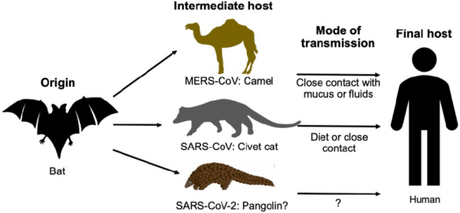The novel SARS-CoV-2, responsible for causing COVID-19, was first reported from stallholders working at the Seafood Market in Wuhan, the capital of the Hubei province of China. There is a fair amount of consensus amongst experts that the virus originated in bats, and through an intermediate mammal, which was being sold at the wet market in Wuhan, was transmitted to human beings. The WHO Situation Report number 22 also stresses the fact that it has been demonstrated that coronaviruses circulate in bats, with a special affinity for bats belonging to the Rhinolophus sub-species. These bats are abundantly found in South China, and across Asia, the Middle East, Africa and Europe.[1] Existing evidence indicates that over 500 types of coronaviruses have been isolated from bats, and antibodies against bat-CoV have been found in 2.9% of rural populations living close to natural bat habitats. This indicates a predilection for bat-coronaviruses to be transmitted to humans.[2]
Phylogenomic analyses conducted in January-February 2020 in China, also indicates that the bat-CoV and the SARS-CoV-2 share a common ancestor, and share genetic similarities with bat CoVs isolated from 2015 to 2017, in Zhoushan, Zhejiang Province, China.[3]
Genomic characterization of viruses isolated from nine patients, of whom eight had visited the seafood market in Wuhan, were found to be extremely similar, with over 99.98% sequence identity. The isolates were related to two bat-derived severe acute respiratory syndrome (SARS)-like coronaviruses, bat-SL-CoVZC45 and bat-SL-CoVZXC21, collected in 2018 in Zhoushan, eastern China, showing 88% sequence identity. However, they were sufficiently distinct from SARS-CoV (2003) and MERS CoV (2012) to warrant consideration as a novel human-infecting virus.[4] Further strengthening this evidence, SARS-CoV-2 shows 96.2% overall genome sequence identity with a bat coronavirus (BatCoV RaTG13), which was isolated from a Rhinolophus affinis bat from the Yunnan province of China in 2017.[5]
There has been a fair amount of speculation about the intermediate hosts, but no definitive evidence has been found to link a mammalian species as the intermediate host in the transmission chain. Some research efforts have identified SARS-CoV-2 related viruses from Malayan Pangolins and seem to indicate that these animals could be a potential intermediate host for the virus.[6-8]However, definitive evidence linking these animals as the principal or sole hosts is lacking.
From the previous outbreaks of SARS and MERS-CoV, definitive transmission pathways have been identified. For SARS, the intermediate host was civet cats, and for MERS CoV, it was camels. The issue of identifying an intermediate host is further complicated by the wide range of animals which were sold at the wet market in Wuhan. According to some published evidence, "the animals sold in the market included poultry (turkey, pheasants, geese, roosters, doves) wild birds (Peacocks, swans, other species), and exotic animals, to reptiles and hedgehogs. The animal list included frogs, camels, wild rabbits, reptiles, snakes, deer, crocodiles, kangaroos, snails, civet cats, goats, centipedes, and cicades".[9]

Summary
- There is evidence-based consensus amongst experts, that the source of the current pandemic could likely be traced back to the seafood market in Wuhan, the capital of the Hubei province, China.
- The virus likely originated from bats but passed through a yet to be identified intermediate host before spilling over to human beings.
- The remarkable genetic similarity with previously identified bat coronaviruses further strengthens this assertion.
- SARS-CoV-2 shows 96.2% overall genome sequence identity with a bat coronavirus (BatCoV RaTG13), which was isolated from a Rhinolophus affinis bat from the Yunnan province of China in 2017.
- SARS-CoV-2 isolates from nine patients, eight of whom had visited the seafood market in Wuhan, showed 99.98% sequence identity amongst each other, and were related to two bat-derived severe acute respiratory syndrome (SARS)-like coronaviruses, bat-SL-CoVZC45 and bat-SL-CoVZXC21, collected in 2018 in Zhoushan, eastern China, showing 88% sequence identity.
- Pangolins have been proposed as an intermediate host, but there is no definitive evidence to support this claim.
References
[1] WHO Novel Coronavirus situation report 22 (11 February, 2020): https://www.who.int/docs/default-source/coronaviruse/situation-reports/20200211-sitrep-22-ncov.pdf?sfvrsn=fb6d49b1_2
[2] Wang, N., Li, S.Y., Yang, X.L., Huang, H.M., Zhang, Y.J., Guo, H., Luo, C.M., Miller, M., Zhu, G., Chmura, A.A. and Hagan, E., 2018. Serological evidence of bat SARS-related coronavirus infection in humans, China. Virologica Sinica, 33(1), pp.104-107.
[3] Liangsheng Zhang, Fu-ming Shen, Fei Chen, Zhenguo Lin, Origin and Evolution of the 2019 Novel Coronavirus, Clinical Infectious Diseases, , ciaa112, https://doi.org/10.1093/cid/ciaa112
[4] Lu R, Zhao X, Li J, et al. Genomic characterisation and epidemiology of 2019 novel coronavirus: implications for virus origins and receptor binding. Lancet. 2020;395(10224):565-574. doi:10.1016/S0140-6736(20)30251-8
[5] Zhou P, Yang XL, Wang XG, et al. A pneumonia outbreak associated with a new coronavirus of probable bat origin. Nature. 2020;579(7798):270-273. doi:10.1038/s41586-020-2012-7
[6] Lam TT, Jia N, Zhang YW, et al. Identifying SARS-CoV-2-related coronaviruses in Malayan pangolins [published online ahead of print, 2020 Mar 26]. Nature. 2020;10.1038/s41586-020-2169-0. doi:10.1038/s41586-020-2169-0
[7] Xiao K, Zhai J, Feng Y, et al. Isolation of SARS-CoV-2-related coronavirus from Malayan pangolins [published online ahead of print, 2020 May 7]. Nature. 2020;10.1038/s41586-020-2313-x. doi:10.1038/s41586-020-2313-x
[8] Liu P, Jiang JZ, Wan XF, et al. Are pangolins the intermediate host of the 2019 novel coronavirus (SARS-CoV-2)?. PLoS Pathog. 2020;16(5):e1008421. Published 2020 May 14. doi:10.1371/journal.ppat.1008421
[9] El Zowalaty ME, Järhult JD. From SARS to COVID-19: A previously unknown SARS- related coronavirus (SARS-CoV-2) of pandemic potential infecting humans - Call for a One Health approach. One Health. 2020;9:100124. Published 2020 Feb 24. doi:10.1016/j.onehlt.2020.100124
[10] Yi Y, Lagniton PNP, Ye S, Li E, Xu RH. COVID-19: what has been learned and to be learned about the novel coronavirus disease. Int J Biol Sci. 2020;16(10):1753-1766. Published 2020 Mar 15. doi:10.7150/ijbs.45134
